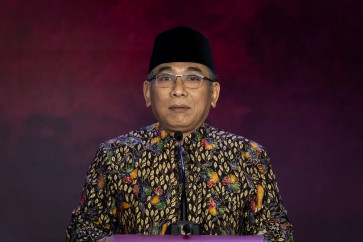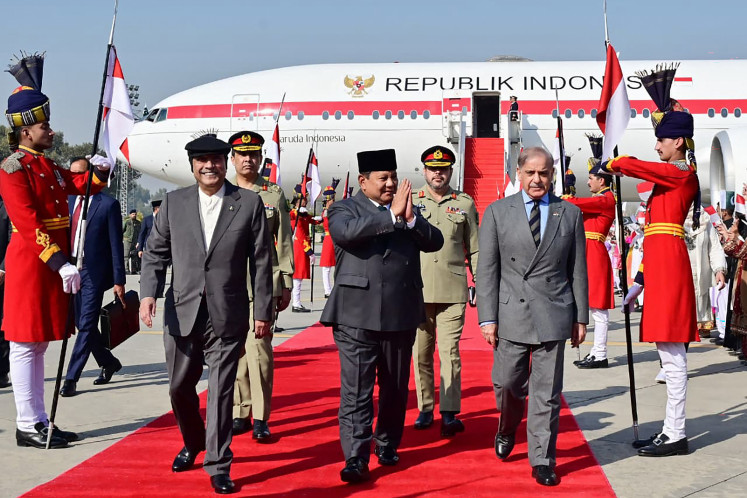Popular Reads
Top Results
Can't find what you're looking for?
View all search resultsPopular Reads
Top Results
Can't find what you're looking for?
View all search resultsHow to act and think like a leader
Jacob, a 35-year-old production manager for a mid-sized European food manufacturer, says, âIâm like the fire patrol
Change text size
Gift Premium Articles
to Anyone
J
acob, a 35-year-old production manager for a mid-sized European food manufacturer, says, 'I'm like the fire patrol. I run from one corner to the other to fix things, just to keep producing.'
Following a buyout of his company by a private investor, Jacob's responsibilities had changed ' although his job title had not. He was now being asked to manage two plants. With a new location, a distant boss and few peers with whom he could exchange ideas about modernizing the plants, he was not best placed to step up to the leadership challenge.
Jacob saw himself as a demanding, hands-on leader; his direct reports were tired of his constant micro-management and bad temper. He knew he should be focused on strategic issues such as how best to expand the business, how to increase collaboration, and how to anticipate the fast changing market. But, somehow he never got to it. His solution was to try to set aside two hours of uninterrupted thinking time every day. With the constant fire-fighting and cross-functional conflicts at the factories, it wasn't working.
Many executives like Jacob believe that if they just carve out more time to think, they will have more and better strategic ideas.
This is not only wishful thinking, it's backward thinking.
We are much more likely to act our way into a more strategic way of thinking, than to think our way into strategic action.
As I explain in my book, Act Like a Leader, Think Like a Leader, what Jacob is lacking is not thinking time but 'outsight' ' the fresh, external perspective we can get when we do new and different things ' plunge ourselves into new projects and activities, interact with very different kinds of people, and experiment with new ways of getting things done ' and then observe the results of our actions. Reflection wasn't going to help him because his deep-seated way of thinking was precisely what was keeping him from making the behavioral adjustments necessary for leadership.
The competency trap
To be successful, Jacob first needs to redefine his job by shifting his focus from improving current factory operations to creating a shared strategic vision among his functional peers so that his manufacturing operations are better aligned with organizational priorities. He has typically fallen into the competency trap of doing what he does and likes best. He needs to move away from the comfort of the old familiar routine and to start to prioritize activities that will make him more attuned to his outside environment.
We enjoy what we do well, so we do more of it and we get better at it.
When we allocate more time to what we do best, we devote less time to learning other things that are also important.
Over time it gets more costly to invest in learning to do new things.
Like most of us, Jacob came to define his jobs in terms of his core strengths and skills. Moving forward he needs to make the transition from work firmly rooted in his own functional knowledge to work that depends on guiding diverse parties, many outside his direct control, to a shared goal'that is, the work of leadership.
Becoming a bridge
The most valuable role that Jacob can play is to be a bridge or linchpin between the production environment and the rest of the organization. The exchanges and interactions with a diverse array of current and potential stakeholders are not distractions from his real work but are actually at the heart of his new role. As experienced leaders understand, lateral and vertical relationships with other functional and business unit managers are a critical lifeline for figuring out how our contributions fit into the overall picture and how to sell our ideas, learn about relevant trends and compete for resources.
Vivienne Cox is a classic example of the leader as a bridge between her team and the relevant parties outside her team. When she took charge of a newly formed Gas, Power and Renewables group at BP, she inherited a number of small, 'futuristic' but peripheral businesses, including solar and wind energy and hydrogen gas. A neophyte on alternative energy, Cox gathered inputs from a broad group of outsiders to her group and company to analyze the business environment and to brainstorm ideas. These conversations brought to light the urgency of moving away from a purely petroleum-based business model. Her success is well documented.
No matter what kind of organization you work in, team leaders who scout ideas from outside the group, seek feedback from and coordinate with a range of outsiders, monitor the shifting winds within the organization, and obtain support and resources from top managers outperform those who dedicate themselves solely to managing inside the team. Part of the secret of their success is that all their bridging activity gives them the outsight they need to develop a point of view on their business, see the big picture organizationally, and set direction accordingly.
Be more playful with yourself
Moving into a bigger leadership role usually involves a shift from having good ideas to selling them to diverse stakeholders. But Jacob, like many inexperienced leaders, finds the process of getting buy-in distasteful and 'inauthentic' because it feels artificial and political to him; he believes that his work should stand on its own merits.
As much as transitions require us to move way beyond our comfort zones, they can also trigger a strong countervailing impulse to protect our past identities. We easily retreat to old habits, especially those that have been rewarded in the past.
Making significant changes, not just in what we do but how we do it, requires a playful frame of mind. I recommend that people think of leadership development as 'playing with' rather than 'working on' their identity (which, let's face it, is not much fun). When we adopt a playful attitude, we're more open to a diverse, even divergent, set of possibilities. It's OK to be inconsistent from one day to the next. We're not being a fake. That's just how we figure out what's right for the new challenges we face. The trick is to work toward a future version of your authentic self by stretching way outside the boundaries of who we are today.
In essence, knowing the kind of leader we'd like to become is not the starting point on our development journey, but rather the result of increasing our outsight. By redefining our job, network and ourselves ' and by acting on all three ' we will gain the experiences we need to reflect on and learn from them. Through this process, our outsight is acquired on what it means to be a leader.
Three subsequent blogs will focus in greater detail on how to start redefining your job; networking across and out; and being more playful with your 'self', together with managing the stepping up process. Sometimes the journey leads to a major career shift; other times, the transition is internal: you've changed the way you see your work and yourself. Whichever way, the time to start acting is now. (Herminia Ibarra)
________________
The writer is INSEAD professor of Organisational Behaviour and the Cora Chaired Professor of Leadership and Learning
This article is republished courtesy of INSEAD Knowledge (http://knowledge.insead.edu) Copyright INSEAD 2014.










